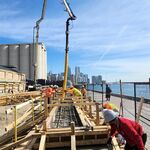north-of-anything
Active Member
I don't think skipping interchange stations like Gerrard and Osgoode make sense. And those that intersect major streetcar routes (Gerrard, Sumach, Bathurst and Queen).
Still, that's not where the express benefit is found. Why not do the extensions beyond where the density is?
Where would the express benefit be found if there aren't any downtown stops that are skipped? If stops are skipped between Danforth and Sheppard, making the train stop at Dufferin, Spadina, Sumach, Gerrard, etc. negates that benefit. Riders within Toronto would be the ones getting skipped over, and riders from outside Toronto typically aren't headed to destinations along Gerrard, Sumach, Dufferin...
I understand why it's important to give streetcars connections to the rest of the system, but that can be done with local trains. If we're using New York as an example of express trains, not all express trains make stops to transfer with every line, and if we don't do the same here then we aren't really getting much of an express service.
GO passengers away from Union station? I don't see what getting people to transfer at Gerrard (have you seen how many escalators will be required to transfer?) or East Harbour (or somewhere in the west) has to do with track gauge.
Well, first of all, I personally don't support using Gerrard as a transfer point. East Harbour makes the most sense to me if you need to go to Union specifically. Secondly, if the Relief Line has RER tracks then GO passengers can simply use the TTC or PATH network from Queen as a last-mile solution. Plus, I'm sure a significant amount of Union-bound passengers are headed towards destinations between King and Bloor, which means stopping at Queen would make their commute faster.
The reason I brought up track gauge is that if we use at least two tracks of standard gauge through the Relief Line, we can completely reroute Richmond Hill service through the line, and possibly Barrie service as well. This would make it easier to upgrade RER service along the Richmond Hill corridor (since the Don Valley tracks are flood-prone and Metrolinx is not interested in flood-proofing them), which would in turn make the GO corridor a more attractive and faster alternative to downtown than Line 1. This will also draw commuters away from the Yonge North extension!
Using entirely standard gauge tracks would mean local service on the relief line would use standard gauge, which is a huge plus for Metrolinx which is using the gauge everywhere else right now. It may preclude turning the rest of the TTC's subways into standard gauge down the road, which would definitely be the hard part.





